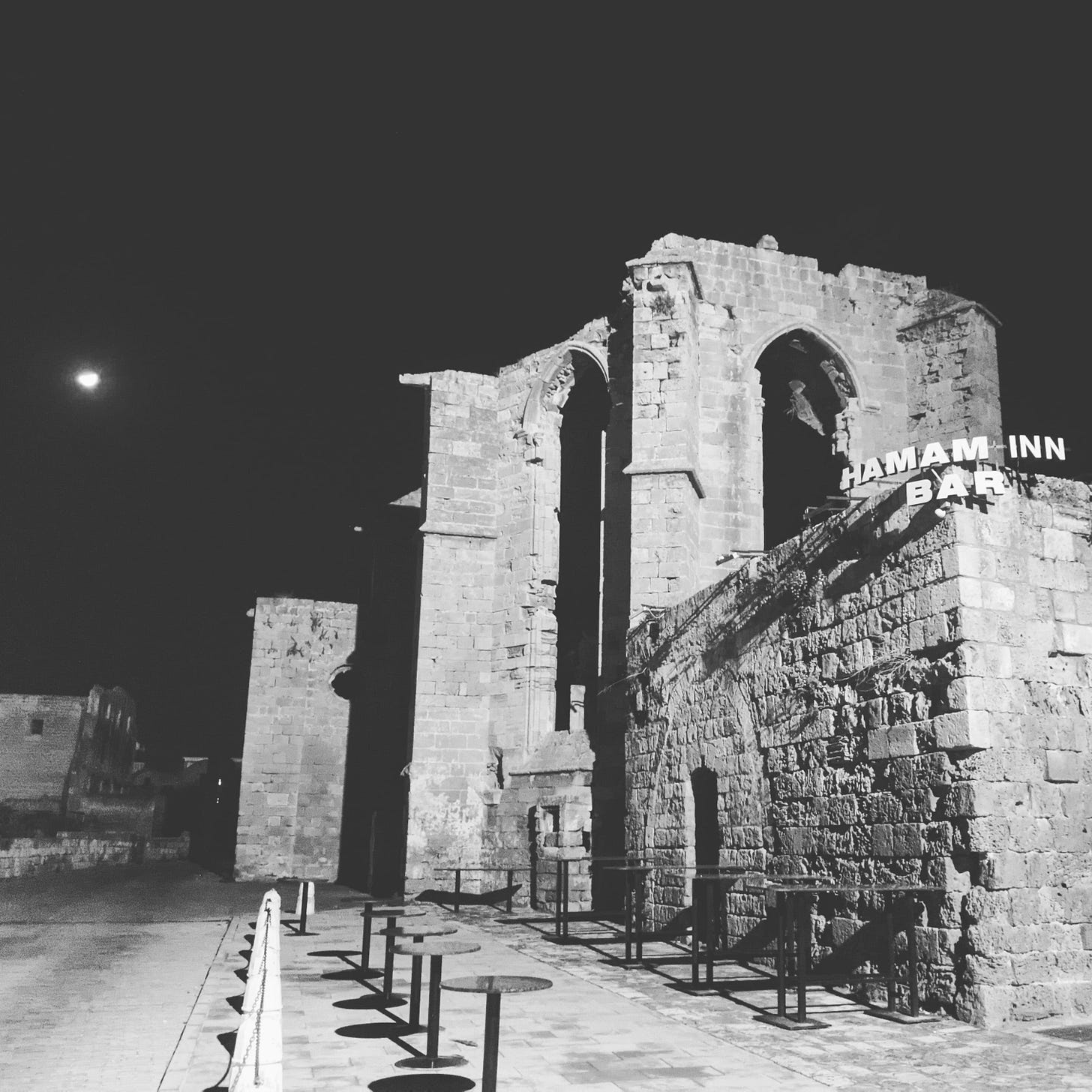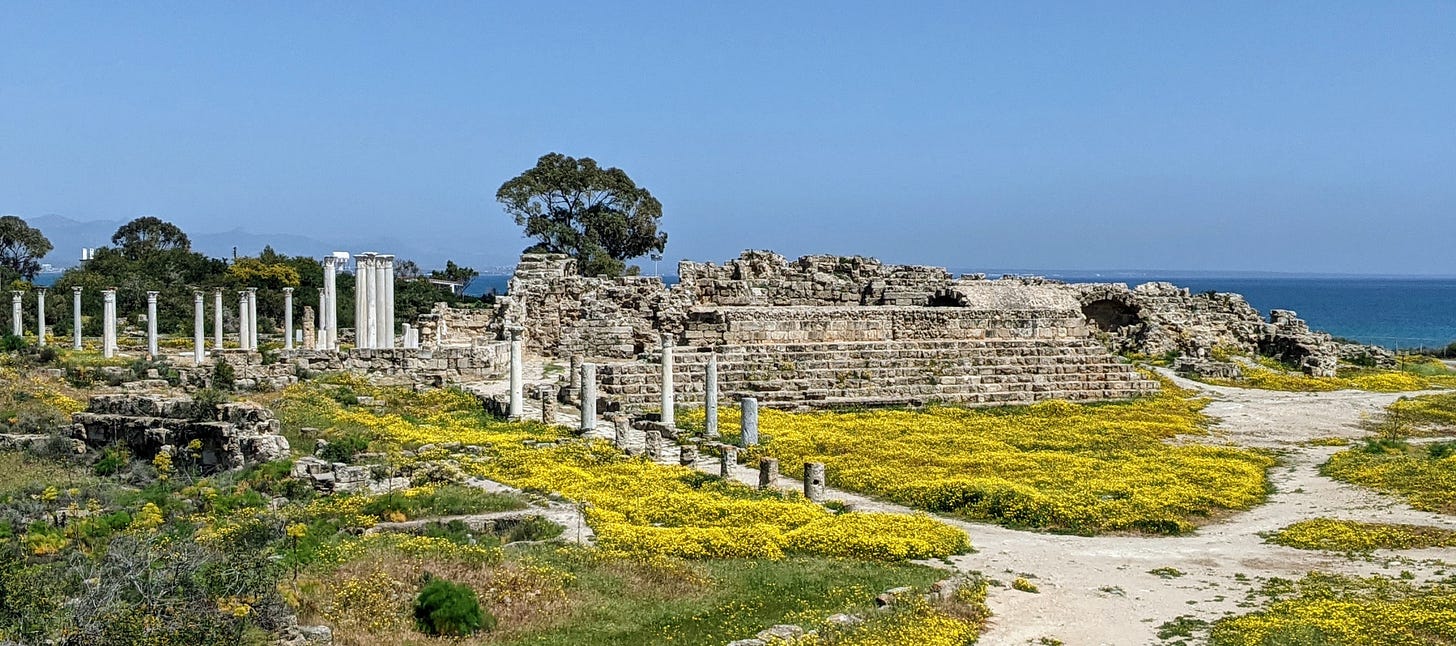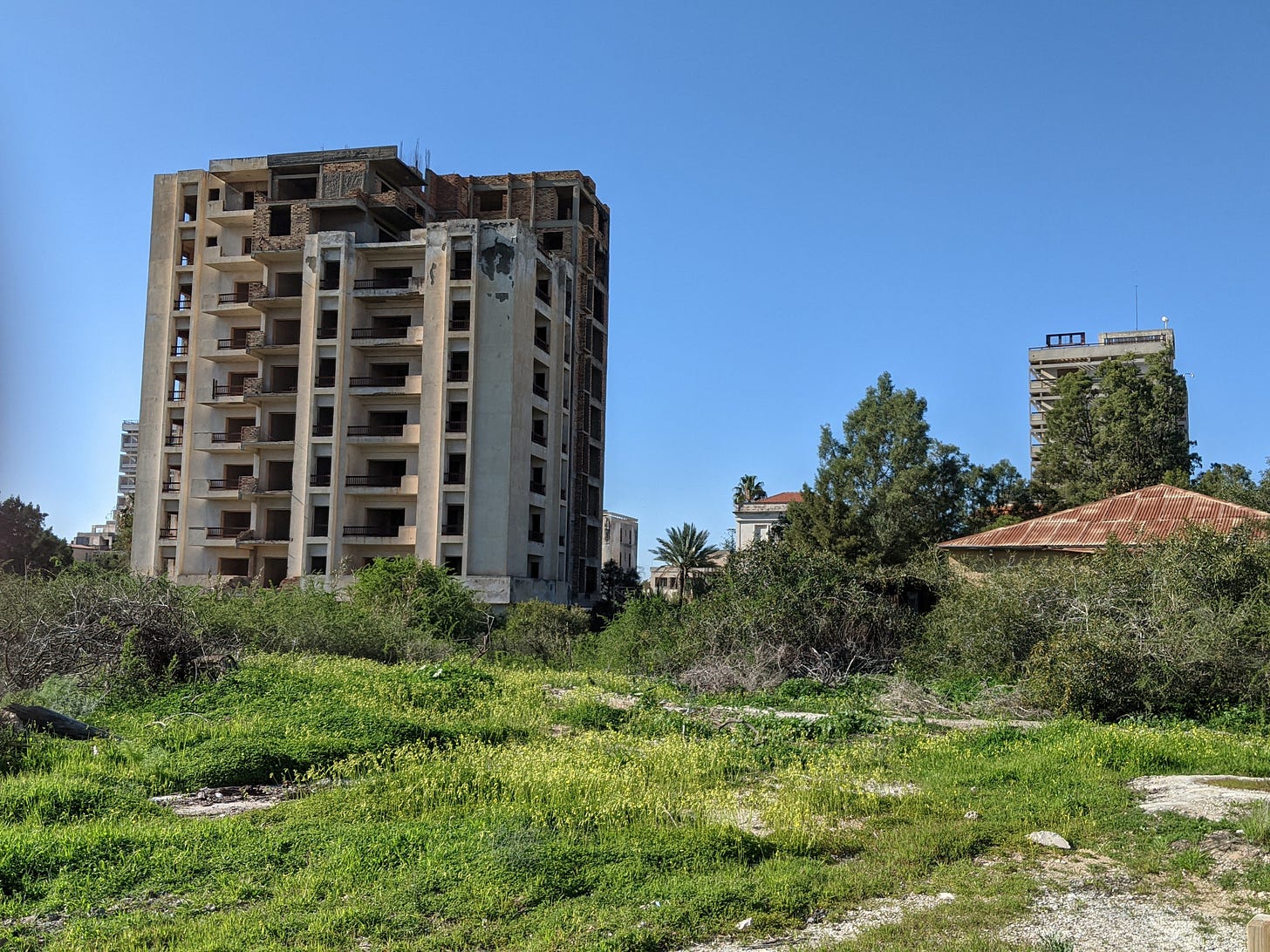Famagusta Collage, Part I: The city of the horned god
Bronze Age Engomi and the scramble over copper
Hey, for this Famagusta miniseries I’m trying something different—a read-along! If you’re interested, you can listen to me read the post by hitting the “play” button above.

“I seized the king of Alashiya with his wives, his children… All the goods, including silver and gold, and all the captured people I removed and brought home to Hattusa. I enslaved the country of Alashiya, and made it tributary on the spot.”
—Hittite tablet of Tudhaliya, republished in Eric Cline’s “1177 B.C.: The Year Civilization Collapsed” (Princeton University Press, 2014)
The Middle East. Various states vie for a strategic resource critical to military supply chains and the international economy. The various geopolitical players intervene and colonize regions critical to the acquisition and production of this resource.
But this resource is not oil or natural gas. Four thousand years ago, it was copper, fought over in the same region where those fossil fuel-centric conflicts are being played out today.
The name of the island of Cyprus may be the inspiration for the name of copper, or else the metal copper gives us the name of the island. Either way, Cyprus was famous first for its copper.
Copper was a critical resource for the production of bronze, an amalgam of copper and tin, crucial in the production of bronze tools and weapons, a technological linchpin for early Mesopotamian, Anatolian, Hellenic, and Egyptian civilizations.

And Engomi, an ancient city on the east coast of Cyprus—being the capital of the Bronze Age kingdom of Alashiya (the original name of the island)—was a crucial broker in the strategic race for access to copper ore. The Hittites, Greeks, and Egyptians—they all wanted a piece of the copper pie.
While the world of the Bronze Age collapsed around 1177 B.C.E.—due to invasions of mysterious “Sea Peoples,” climate change, or a combination of such factors—Engomi’s rise would be followed in the classical era by impressive cities erected near the same ground.
Engomi’s urban successors would be equally strategic, but for different reasons. From Salamis to Constantia, the city that became Famagusta has always been surrounded by ruins from an earlier time.

The legacies of Famagusta
The city of Famagusta is one of the most fascinating locations on the island of Cyprus. Its name in Greek, Αμμόχωστος, means “hidden in the sand.” The setting of Shakespeare’s classic play Othello, the various urban areas in and around Famagusta have been an important center from the oldest periods of recorded antiquity in the Bronze Age—all the way to the modern Cypriot conflict.
With such a rich history, Famagusta is also a good lens into the long and tumultuous history of Cyprus. As The Cyprus Files blog series moves closer to its “endgame,” I wanted to tackle the multifaceted story of Famagusta, a narrative I’d been saving for a more ambitious approach: history as collage.
In this five part series, we’ll go into the history of Famagusta. Part I considers the region in the Bronze Age, when the settlement of Engomi was an important center and capital for Cyprus, then the strategic source of copper.
In Part II, we’ll fast-forward to ancient Greek and Roman times, when Salamis (later rebuilt as Constantia) became one of the more important cities on the island.
In Part III, we’ll consider Famagusta in the medieval period, when Frankish crusaders and later Venetians turned Famagusta into the last trading outpost on the route to the Middle East, before a bruising invasion by the Ottoman Empire and a new role within the Ottoman state.
In Part IV, we’ll consider Famagusta in the waning days of the British Empire’s hold over the island, when it became the home of detention camps for Jewish zionists, a chapter dramatized in the Leon Uris novel Exodus and its film adaptation (filmed on location).
Finally, in Part V, we’ll take a look at the ghost city of Varosha, once the prospering Greek Cypriot neighborhood and tourism center on the island. Since the Turkish invasion and occupation of the north of the island in 1974, Varosha has become an abandoned city, recently converted into a dark tourism destination.
We’ll take our time with this Famagusta miniseries, but it should wrap up in summer 2023. But enough of scheduling—let’s run it back to copper.
Copper towns
The city of Engomi was established around 1700 B.C.E.—about four thousand years ago. A center of copper processing, Engomi was a location where Mycenaean Greeks settled (apocryphally, the Greeks who went to war with Troy). The people at Engomi worshipped the “Horned God,” thought to be an early version of Apollo.
Back then, Cyprus was coming under the geopolitical influence of both the Greeks and by 850 B.C., the Phoenicians (hailing from modern-day Lebanon), alongside cities of Eteo-Cypriote origin (the island’s original inhabitants), such as the copper-centric city of Idalion.
Cypriot copper was mined at the foot of the Troödos mountains. “The amount of slag found near the ancient mines exceeds four million tons,” wrote historian Katia Hadjidemetriou. She added, “It is today estimated that at least two hundred thousand tones of copper ore were produced in ancient Cyprus. This huge production undoubtedly renders Cyprus the biggest centre of copper ore production in antiquity.”
Such success made Cyprus a target that made it even further integrated in the Bronze Age world. Two Hittite kings claim to have conquered Cyprus in a period of instability ahead of the Bronze Age collapse in 1177 B.C.E. When the breakdown of these civilizations came, Cyprus was part of the story. In the ruins of the palace of Ugarit, a port city in modern-day Syria, a letter addressed to the king of Alashiya on a tablet was found, suggesting it had never been sent (though this document is heavily studied and debated). The letter said, “the ships of the enemy have come. They have been setting fire to my cities and have done harm to the land.” The letter requested assistance.
The disturbances in the Eastern Mediterranean were so damaging that by 1085 B.C.E., an Egyptian messenger visiting Byblos (modern-day Jbeil in Lebanon) was blown off course to Cyprus, and he probably visited Engomi. “The people of the city came out in order to slay me,” the Egyptian recounted. “I was dragged by them to the place where Hathaba, the queen of the city, was.” To his relief, a member of the queen’s court spoke Egyptian, and through the courtier’s translation the Egyptian begged for pardon as an ambassador of the Pharoah. “She said to me: ‘Lie down and sleep.’” Thanks to his connections, the Egyptian had found refuge. But it would not remain as such forever. Engomi was fully abandoned by 700 B.C.E.
After the crises of the 12th century B.C.E., most of the Bronze Age civilizations receded into a “Dark Age,” with the exception of Egypt. And out of that period grew the civilizations of the classical period, lending bloom to Famagusta’s next major flourishing—as the city of Salamis.
Sources
Cline, Eric. 1177 B.C.: The Year Civilization Collapsed (Princeton University Press: Princeton, 2014).
Hadjidemetriou, Katia, (trans. by Costas Hadjigeorgiou). A History of Cyprus (Cassoulides Masterprinters: Nicosia, 2018).

This is the thirty-second post in The Cyprus Files, a newsletter series from The Usonian chronicling my Fulbright experiences in Cyprus. Thanks for reading, and if you haven’t subscribed to The Usonian to read about storytelling and design from the edge, please consider joining the list.



